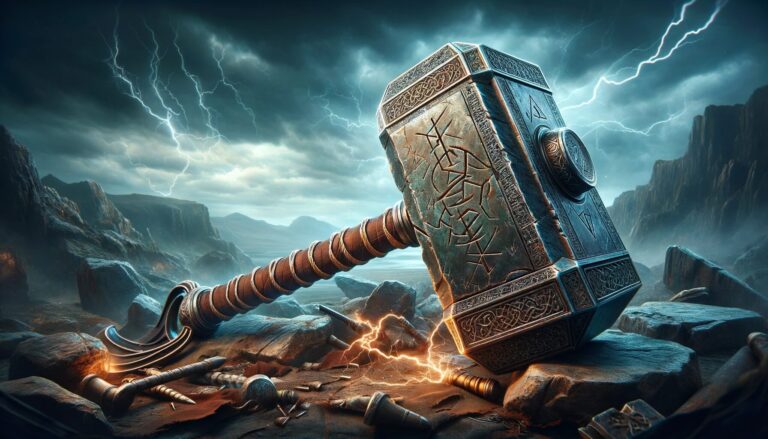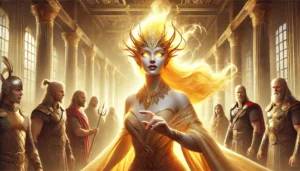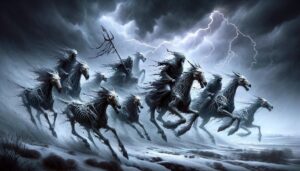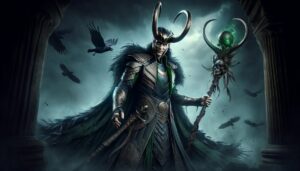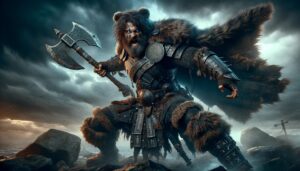Table of Contents
In the realm of Norse mythology, the thunderous resonance of Mjölnir, pronounced “Miol-neer,” echoes through the ages as a symbol of unparalleled power and divine protection. This legendary hammer, wielded by the thunder god Thor, is a symbol of immense significance, embodying the strength to both preserve the cosmic order and unleash destructive forces.
The Origins
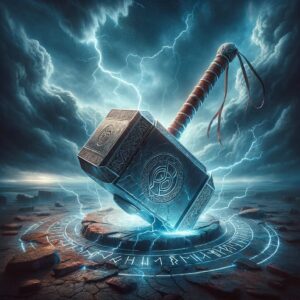
Mjölnir’s creation is shrouded in intrigue and masterful craftsmanship. According to Norse mythology, the god Loki, often referred to as the trickster, played a central role in its inception. Loki’s mischievous nature led him to commit an act that would set the stage for the forging of this mighty weapon. In a fateful encounter, Loki severed the golden locks of hair belonging to Thor’s wife, Sif, which infuriated the thunder god.
Thor’s anger knew no bounds, and he threatened Loki with dire consequences. However, Loki, ever the cunning one, managed to evade Thor’s wrath by making a bold promise. He vowed to obtain even lovelier locks of hair for Sif, which he would acquire from the skilled dwarves residing in Svartalfheim, the land of the dwarves.
Master Craftsmanship
The dwarves of Svartalfheim were renowned for their unparalleled craftsmanship, and Loki’s task was not an easy one. Nevertheless, Loki successfully deceived the dwarves into crafting not only beautiful hair for Sif but also other remarkable treasures. Among these treasures were the ship Skidbladnir, which could fold to fit in one’s pocket and always had the best winds in its sails, and the formidable spear Gungnir.
Loki’s fascination with the dwarves’ craftsmanship led him to seek further treasures. He manipulated two dwarf brothers, Brokkr and Sindri, into crafting more wondrous items for him. Loki wagered that these dwarves would not be able to surpass the treasures created by the other two dwarf brothers. Despite Loki’s interference, Sindri succeeded in crafting Mjölnir, Thor’s hammer. However, due to Loki’s antics, the hammer ended up with a shorter handle than intended.
The Dwarves’ Claim and Loki’s Foiled Escape
The dwarf brothers Brokkr and Sindri journeyed to Asgard, the realm of the gods, to claim their rightful payment for the magnificent treasures they had created. However, Loki, known for his swiftness, arrived in Asgard first. Loki distributed the treasures to the gods: Mjölnir to Thor, the golden hair and Gungnir to Odin, and the ship and the golden-haired boar to Freyr.
The gods acknowledged Loki’s obligation to fulfill his agreement with the dwarf brothers, which involved offering his head as payment. Yet, Loki, ever the trickster, managed to elude this dire fate by arguing that he had not promised them his neck, only his head. In the end, the dwarves settled for sewing Loki’s mouth shut, sparing his life but silencing his deceitful tongue.
Mjölnir’s Versatility and Significance
Thor’s hammer, Mjölnir, served multiple purposes within Norse mythology. Transitioning to the hammer’s functions, we find that it was more than just a weapon. It was also a ceremonial tool and an instrument of blessing in various life events, including births, weddings, and possibly funerals. The hammer’s symbol was found on many grave stones up to 1300 AD, underscoring its enduring cultural significance.
One particular story from the Poetic Edda recounts how a giant managed to steal Mjölnir and demanded the goddess Freyja’s hand in marriage as the price for its return. Thor, with his cunning and the aid of his magical disguise, managed to reclaim Mjölnir, thwarting the giant’s plans and annihilating the would-be bridegroom.
Thor’s Hammer as a Symbol
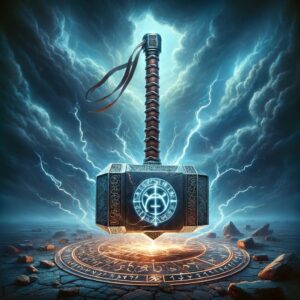
In the context of Christianization in Northern Europe, the significance of Mjölnir grew. While the Christian cross dominated, adherents of ancient beliefs adopted Thor’s hammer as a distinct emblem. It marked their resistance, distinguishing them as guardians of traditional culture against Christian conversion.
Mjölnir symbolized the struggle to protect the innangard, the realm of order, from the giants’ chaos. It echoed the Norse people’s determination to preserve their customs and beliefs amidst external pressures.
Special powers
Destructive Power: Mjölnir is famed for its devastating capabilities, capable of shattering mountains, crushing giants, and defeating any adversary in Thor’s path. This destructive prowess underscores Thor’s duty as a protector.
Returning Ability: A defining trait of Mjölnir is its innate ability to return to Thor’s hand when thrown, regardless of distance or speed. This remarkable feature allows Thor to unleash rapid and unerring strikes during battle.
Weather Control: In Norse mythology, Thor commands the forces of thunder and storms, and Mjölnir grants him control over the elements. With each strike of the hammer, thunder and lightning reverberate, emphasizing his mastery over nature’s fury.
Protection: Mjölnir serves as a protective talisman, shielding Thor and those under his care with formidable barriers and shields. These defensive capabilities symbolize Thor’s role as a guardian and defender of the realms.
Fertility and Blessing: In certain Norse traditions, Mjölnir takes on a role in rituals related to births, weddings, and potentially even funerals. Its presence in these ceremonies symbolizes blessings and the orderly transition of life events.
Symbol of Thor’s Authority: Mjölnir stands as an emblem of Thor’s divine authority and rightful rule. When wielded, it signifies his status as the defender of Asgard and Midgard, ensuring cosmic order is maintained.
Resistance to Enchantment: Mjölnir’s resilience against enchantments and spells renders it nearly indestructible. This attribute solidifies its status as a divine and invincible weapon.
Symbol of Identity: Beyond its function as a weapon, Mjölnir represents Norse identity and cultural heritage. In modern times, it connects individuals to ancestral traditions and signifies resistance against external influences.
Defeat of Giants: Thor’s hammer plays a pivotal role in vanquishing giants and chaos in Norse mythology. Its use in thwarting the giants’ schemes highlights its role in preserving cosmic balance and safeguarding the realms.
Empowerment of Thor: Mjölnir acts as a conduit for Thor’s godly powers, enhancing his formidable abilities. With the hammer in his grasp, Thor becomes an even mightier force, prepared to face the most formidable adversaries and challenges.
Modern Use
In modern times, Mjölnir’s symbol remains significant. Neopagans, especially Asatru followers, proudly use it to connect with ancestral traditions and honor gods. Marvel Comics and films have further popularized Thor’s hammer worldwide, solidifying its status as a symbol of power and heroism.
Conclusion: Mjölnir’s Enduring Legacy
Mjölnir, Thor’s legendary hammer, remains an enduring symbol of strength, protection, and cultural identity. Rooted in Norse mythology, Mjölnir’s origins endure through time, resonating with heritage preservation and embracing its power. As a testament to the ancient Norse gods’ enduring legacy, Mjölnir symbolizes resistance against change, echoing determination to uphold traditions.
FAQ
How do you pronounce Mjölnir?
It is pronounced as "Mee-ol-neer" with the emphasis on the first syllable, "Mee."
What are Mjölnir's powers and abilities?
Mjölnir possesses powers including destructive force, weather control, the ability to return to Thor's hand when thrown, and protection against enchantments.
Who forged Mjölnir?
Mjölnir was forged by the skilled dwarf brothers, Brokkr and Sindri (also known as Eitri), in Norse mythology.
Why is Mjölnir important in Norse mythology?
Mjölnir symbolizes Thor's role as a protector of the realms and embodies his divine authority. It is central to many Norse myths and stories.
Can anyone besides Thor wield Mjölnir?
In most Norse myths, only Thor, the god of thunder, can wield Mjölnir due to his divine status. Others who attempt to lift it are unsuccessful.
What does Mjölnir symbolize in modern times?
In contemporary culture, Mjölnir symbolizes power, heritage, and resistance. It is associated with Neopaganism and is featured in Marvel Comics and films.
How does Mjölnir relate to Norse cultural identity?
Mjölnir serves as a symbol of Norse cultural heritage, connecting individuals to ancestral traditions and symbolizing resistance against external influences.
Can Mjölnir be destroyed or lost?
In Norse mythology, Mjölnir is considered nearly indestructible and is closely associated with Thor. It is not typically depicted as being lost or destroyed.
